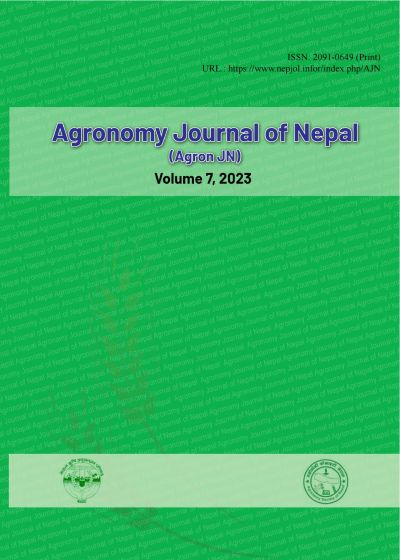Effect of Plant Density and Fertilizer Management Practices on Yield of Spring Maize
DOI:
https://doi.org/10.3126/ajn.v7i1.62060Keywords:
Fertilizer, Management, Plant density, Spring Maize, YieldAbstract
The grain yield of maize is lowered by an insufficient plant population and an unbalanced fertilizer application. An experiment was carried out in the spring to address these problems. The treatments were set up in a split-plot design with three replications and included factorial combinations of three planting densities and four fertilizer levels: 120:60:40 kg N, P2O5, K2O ha-1, 120% RBR, 150% RBR, and site-specific nutrient management (SSNM), 140:40:40 kg N, P2O5, K2O ha-1. Both the barrenness and sterility percentages were higher (p<0.05) for the highest planting densities and the lowest for the lowest plant densities. A higher (p<0.05) number of kernels per cob was recorded at the lowest plant density and the highest amount of fertilizer application. For the lowest and highest plant densities, the leaf area index increased the grain yield, whereas longer grain filling duration and less barrenness and sterility increased (p<0.05) the grain yield for all plant densities. The number of kernels per row or cob was the most crucial factor in increasing the yield of maize under a higher plant density, whereas the final plant population was the most crucial factor in increasing the yield under a lower plant density. Due to a higher number of final plant populations and comparable yield traits, the grain yield of the planting density with the highest grain production was significantly higher. The increased amount of fertilizer (144:72:48 N:P2O5:K2O kg ha-1, 180:90:60 N:P2O5:K2O kg ha-1) gave a higher grain yield. The plant densities of 66667 ha-1 and 83333 ha-1 were better, whereas the present recommended dose of N: P2O5:K2O should be increased or need-based SSNM must be adopted to obtain more profits from spring maize.
Downloads
Downloads
Published
How to Cite
Issue
Section
License
Copyright (c) 2023 Agronomy Society of Nepal (ASoN)

This work is licensed under a Creative Commons Attribution-NonCommercial 4.0 International License.
ASON permits for free use, distribution and reproduction in any medium if the original work is properly cited and not used for commercial purposes.




